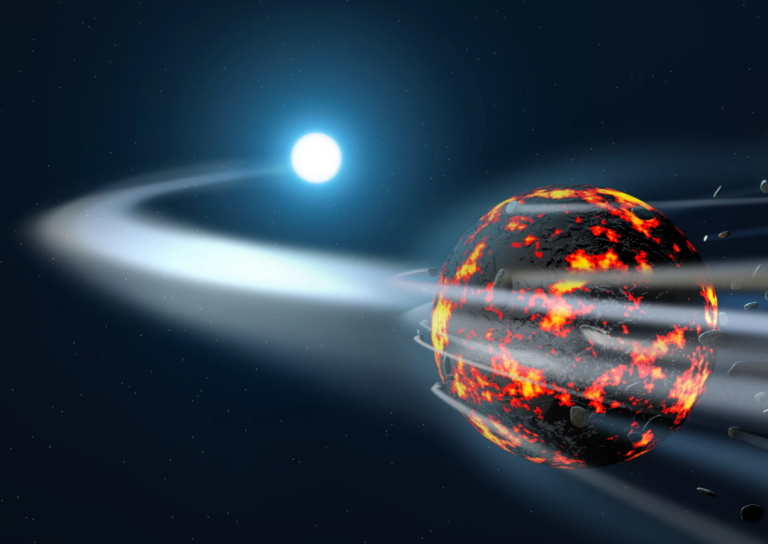Astronomers have observed an unusual phenomenon where a white dwarf star alternates between being active and inactive every half an hour.
White dwarf, a star responsible for cosmic phenomenon, has recently been observed by astronomers via its fluctuating manner in showing brightness, which kept going on and off between 30 minutes to 1 hour.
The discovery however was reported as “extraordinary” by a team of astronomers from Durham University and their collaborators around the globe, who were observing the data from an abandoned NASA spacecraft which had been initially launched for the search of alien planets.
Their guess didn’t include the fact that the cause was as exceptional as it finally revealed to be; at the beginning instead of that they considered that the disruptions are something that complicates the white dwarf by absorbing energy from the companion star as a binary system.
Given that it is the gravity controlling the material movement out of a donor star and into a main white dwarf, it is hard to imagine one such a short timescale for the star’s output fluctuations.
The data from magnetic field of the white dwarf’s surface revealed that it was rapidly and repeatedly turning itself on or off, which was the first time the researchers had witnessed this phenomenon.
TW Pictoris is a helium star of the main sequence occupying a binary orbit with a separation of about 15 Astronomical Units and has a companion about 4 times as massive as Sun. It is positioned at a distance of approximately 1,400 light years from Earth.
The radiating star mirrors the expanding white dwarf while there is an on-phase, but occasionally it stops to dim, and there is a signal off-phase. ”
Nevertheless, experiencing this shocker is still overwhelming for me since it rarely occur that fast.
However, scientists investigated and confirmed that white dwarf’s embedded magnetic field leads to few asteroids unable to reach the main star. As per the post in Nature Astronomy.
The Centre for Extragalactic Astronomy, Durham City branch, is where the lead author during the research Dr. Simone Scaringi came from. “The fluctuating intensity in white magnified binary systems is space isn’t a very fast one, it takes place from days to months,” said Scaringi.
“The moment of declining of TW Pictoris and it is the greatest phenomenon that occurred for the last 30 minutes. I have never had the opportunity to watch the other accreting white dwarfs. “
In summary, Dr. Scaringi outlined three main points: “The white dwarf in the Double Pegasus system is still actively accreting matter infalling from the less massive companion star. In this relatively smooth process, periodic ‘gaps’ in the white dwarf’s brightness variations is not expected.
The white dwarf in such systems is way smaller than the donor star and the disk of matter grows continuously as it absorbs the shedding materials from the larger star orbiting around.
“This material tends to spiral toward the white dwarf slowly forming another ring of matter called an accretion disk. Eventually this disk becomes bright and its material then falls onto the surface of the white dwarf. “
He also said, “the disk-giving donors can be monitored, and it is known that in some of them the donor star quits the process of feeding the disk. ” Nevertheless, he admitted that scientists do not know why it happens as of now but allow the disk to be bright for a little while while it “drains” the material that was used to be there.
“This leads to the fact that the disk needs to absorb the main part of material within a period about 1 and 2 months which is the same that we found to be true with different accreting white dwarves,” noted Dr. Scaringi.
“The so-called’magnetic-gating’ comes into play once the material has almost completely drained out: the amount of material that is going to stick on to the white dwarf is not only dependent upon magnetic barrier that rotates along meridianal plane of the white dwarf, but also it’s smooth accretion or not is controlled by the white dwarf’s magnetospheric barrier.
“30 min awaited a drop in the brightness of TW Pictoris after months long drainage of the disc and this was such a surprise,” – said the scientist.
“To me it is like the disk being drained-out fast just like we earlier thought, but instead, we’re looking at some reconfiguration of the white dwarf energy which returns back the disk and pushes it outwards , acting as an edge-inward obstacle to a time when the inner-disk edge can prevail once again,” he claimed.
Scaringi, his voice solemn and truthful, ended with the words, ” …a previously unknown gravity anomaly, ” which felt like she had gotten in the middle of something huge.
This reasoning may open the door to comparing accretion discs around rapidly rotating neutron stars to those around slowly rotating black holes because the neutron stars are by far much smaller. It could be a step forward to getting a better picture of the process of feeding on material that surrounds the rotating objects and the important role of magnetic fields in that particular process.
Do not forget to share your opinion with us to provide you with the best posts !





0 Comments